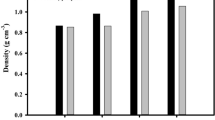Abstract
Activated carbon hollow fibers (ACHFs) with high surface area were prepared from natural ramie fibers (RFs) by one-step activation under different ZnCl2 impregnation concentrations. The results showed that the morphology and pore structure development of ACHFs depend greatly on ZnCl2 concentration because ZnCl2 not only can swell and dissolve cellulose but also can serve as skeleton of newborn pores. It obtained granular activated carbons (ACs) instead of ACHFs when ZnCl2 concentration was over a suitable range. As supercapacitor electrode, the ACHFs possessed the maximum capacity of 287 F g−1 and showed excellent stability with more than 93 % efficiency after 1000 cycles. Besides, ACHFs showed higher electrochemical performance than granular ACs even if their microstructure was similar, indicating the morphology of material is also important to the electrochemical properties. Therefore, supercapacitors using ramie-based ACHFs as electrodes possess high comprehensive properties to serve for the need of backup energy storage and high pulse power applications.






Similar content being viewed by others
References
Wang LL, Guo YP, Zou B, et al (2011) Bioresour Technol 102:1947–1950
Biswal M, Banerjee A, Deo M, et al (2013) Energ Environ Sci 6:1249–1259
He XJ, Li RC, Qiu JS, et al (2012) Carbon 50:4911–4921
Xing BL, Zhang CX, Chen LJ et al (2011) Adv Eng Mater Pts 1–3 194–196:2472–2479
Mallouk KE, Rood MJ (2013) Environ Sci Technol 47:7373–7379
Travis W, Gadipelli S, Guo ZX (2015) Rsc Adv 5:29558–29562
Lam E, Luong JHT (2014) ACS Catal 4:3393–3410
Dutta S, Bhaumik A, Wu KCW (2014) Energ Environ Sci 7:3574–3592
Xia YD, Yang ZX, Zhu YQ (2013) J Mater Chem A 1:9365–9381
Subramanian V, Luo C, Stephan AM, et al (2007) J Phys Chem C 111:7527–7531
Qu WH, Xu YY, Lu AH, et al (2015) Bioresour Technol 189:285–291
Rufford TE, Hulicova-Jurcakova D, Zhu ZH, et al (2008) Electrochem Commun 10:1594–1597
Zhai YP, Dou YQ, Zhao DY, et al (2011) Adv Mater 23:4828–4850
Kim YJ, Lee BJ, Suezaki H, et al (2006) Carbon 44:1592–1595
Luan YT, Wang L, Guo SE, et al (2015) Rsc Adv 5:42430–42437
Balathanigaimani MS, Shim WG, Lee MJ, et al (2008) Electrochem Commun 10:868–871
Wu MB, Ai PP, Tan MH, et al (2014) Chem Eng J 245:166–172
Li MC, Wu QL, Song KL, et al (2015) ACS Sustainable Chem Eng. 3:821–832
Li MC, Wu QL, Song KL, et al (2015) ACS Appl. Mater. Interfaces. 7:5006–5016
Lynd LR, Weimer PJ, van Zyl WH, et al (2002) Microbiol Mol Biol R 66:506–577
Gazit OM, Katz A (2012) ChemSusChem 5:1542–1548
Zhao DS, Li H, Zhang J, et al (2012) Carbohyd Polym 87:1490–1494
Le Moigne N, Navard P (2010) Cellulose 17:31–45
Rutkowski P (2011) Fuel Process Technol 92:517–522
Henniges U, Kostic M, Borgards A, et al (2011) Biomacromolecules 12:871–879
Wu WJ, Wang ZG, Jin YC, et al (2014) Biomass Bioenerg 71:357–362
Caturla F, Molinasabio M, Rodriguezreinoso F (1991) Carbon 29:999–1007
Rodriguezreinoso F, Molinasabio M (1992) Carbon 30:1111–1118
Yue ZR, Mangun CL, Economy J (2002) Carbon 40:1181–1191
De Adhikari A, Oraon R, Tiwari SK, et al (2015) Rsc Adv 5:27347–27355
Lee D, Jung JY, Jung MJ, et al (2015) Chem Eng J 263:62–70
Farma R, Deraman M, Awitdrus A, et al (2013) Bioresour Technol 132:254–261
Ma XJ, Zhang F, Zhu JY, et al (2014) Bioresour Technol 164:1–6
Wan CC, Lu Y, Jiao Y, et al (2015) Carbohyd Polym 118:115–118
Liu YH, Xue JS, Zheng T, et al (1996) Carbon 34:193–200
Kumar K, Saxena RK, Kothari R, et al (1997) Carbon 35:1842–1844
Nahil MA, Williams PT (2012) Biomass Bioenerg 37:142–149
Guo Y, Shi ZQ, Chen MM, et al (2014) J Power Sources 252:235–243
Okajima K, Ohta K, Sudoh M (2005) Electrochim Acta 50:2227–2231
Acknowledgments
The authors gratefully acknowledge the support from the National Natural Science Foundation of China (51302264) and the projects of National Science Foundation for Distinguished Young Scholars of China (51125018).
Author information
Authors and Affiliations
Corresponding authors
Rights and permissions
About this article
Cite this article
Du, X., Zhao, W., Ma, S. et al. Effect of ZnCl2 impregnation concentration on the microstructure and electrical performance of ramie-based activated carbon hollow fiber. Ionics 22, 545–553 (2016). https://doi.org/10.1007/s11581-015-1571-3
Received:
Revised:
Accepted:
Published:
Issue Date:
DOI: https://doi.org/10.1007/s11581-015-1571-3




